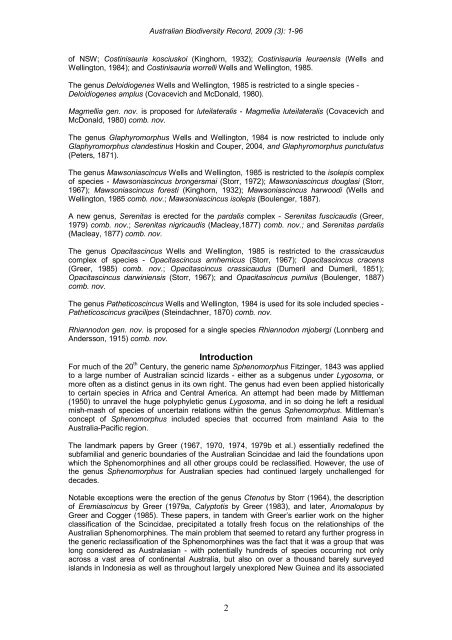AUSTRALIAN BIODIVERSITY RECORD - Calodema
AUSTRALIAN BIODIVERSITY RECORD - Calodema
AUSTRALIAN BIODIVERSITY RECORD - Calodema
Create successful ePaper yourself
Turn your PDF publications into a flip-book with our unique Google optimized e-Paper software.
Australian Biodiversity Record, 2009 (3): 1-96<br />
of NSW; Costinisauria kosciuskoi (Kinghorn, 1932); Costinisauria leuraensis (Wells and<br />
Wellington, 1984); and Costinisauria worrelli Wells and Wellington, 1985.<br />
The genus Deloidiogenes Wells and Wellington, 1985 is restricted to a single species -<br />
Deloidiogenes amplus (Covacevich and McDonald, 1980).<br />
Magmellia gen. nov. is proposed for luteilateralis - Magmellia luteilateralis (Covacevich and<br />
McDonald, 1980) comb. nov.<br />
The genus Glaphyromorphus Wells and Wellington, 1984 is now restricted to include only<br />
Glaphyromorphus clandestinus Hoskin and Couper, 2004, and Glaphyromorphus punctulatus<br />
(Peters, 1871).<br />
The genus Mawsoniascincus Wells and Wellington, 1985 is restricted to the isolepis complex<br />
of species - Mawsoniascincus brongersmai (Storr, 1972); Mawsoniascincus douglasi (Storr,<br />
1967); Mawsoniascincus foresti (Kinghorn, 1932); Mawsoniascincus harwoodi (Wells and<br />
Wellington, 1985 comb. nov.; Mawsoniascincus isolepis (Boulenger, 1887).<br />
A new genus, Serenitas is erected for the pardalis complex - Serenitas fuscicaudis (Greer,<br />
1979) comb. nov.; Serenitas nigricaudis (Macleay,1877) comb. nov.; and Serenitas pardalis<br />
(Macleay, 1877) comb. nov.<br />
The genus Opacitascincus Wells and Wellington, 1985 is restricted to the crassicaudus<br />
complex of species - Opacitascincus arnhemicus (Storr, 1967); Opacitascincus cracens<br />
(Greer, 1985) comb. nov.; Opacitascincus crassicaudus (Dumeril and Dumeril, 1851);<br />
Opacitascincus darwiniensis (Storr, 1967); and Opacitascincus pumilus (Boulenger, 1887)<br />
comb. nov.<br />
The genus Patheticoscincus Wells and Wellington, 1984 is used for its sole included species -<br />
Patheticoscincus gracilipes (Steindachner, 1870) comb. nov.<br />
Rhiannodon gen. nov. is proposed for a single species Rhiannodon mjobergi (Lonnberg and<br />
Andersson, 1915) comb. nov.<br />
Introduction<br />
For much of the 20 th Century, the generic name Sphenomorphus Fitzinger, 1843 was applied<br />
to a large number of Australian scincid lizards - either as a subgenus under Lygosoma, or<br />
more often as a distinct genus in its own right. The genus had even been applied historically<br />
to certain species in Africa and Central America. An attempt had been made by Mittleman<br />
(1950) to unravel the huge polyphyletic genus Lygosoma, and in so doing he left a residual<br />
mish-mash of species of uncertain relations within the genus Sphenomorphus. Mittleman’s<br />
concept of Sphenomorphus included species that occurred from mainland Asia to the<br />
Australia-Pacific region.<br />
The landmark papers by Greer (1967, 1970, 1974, 1979b et al.) essentially redefined the<br />
subfamilial and generic boundaries of the Australian Scincidae and laid the foundations upon<br />
which the Sphenomorphines and all other groups could be reclassified. However, the use of<br />
the genus Sphenomorphus for Australian species had continued largely unchallenged for<br />
decades.<br />
Notable exceptions were the erection of the genus Ctenotus by Storr (1964), the description<br />
of Eremiascincus by Greer (1979a, Calyptotis by Greer (1983), and later, Anomalopus by<br />
Greer and Cogger (1985). These papers, in tandem with Greer’s earlier work on the higher<br />
classification of the Scincidae, precipitated a totally fresh focus on the relationships of the<br />
Australian Sphenomorphines. The main problem that seemed to retard any further progress in<br />
the generic reclassification of the Sphenomorphines was the fact that it was a group that was<br />
long considered as Australasian - with potentially hundreds of species occurring not only<br />
across a vast area of continental Australia, but also on over a thousand barely surveyed<br />
islands in Indonesia as well as throughout largely unexplored New Guinea and its associated<br />
2

















